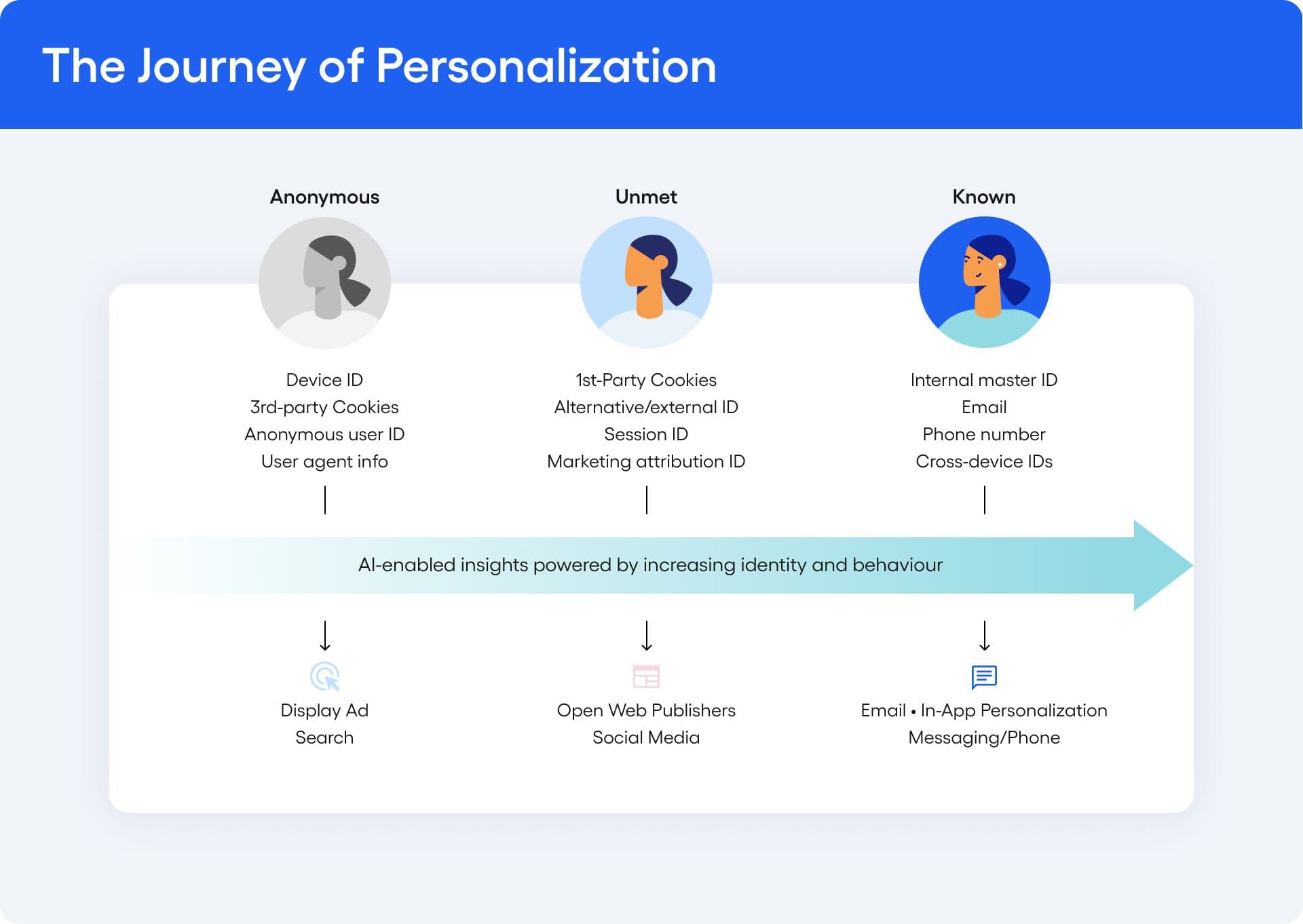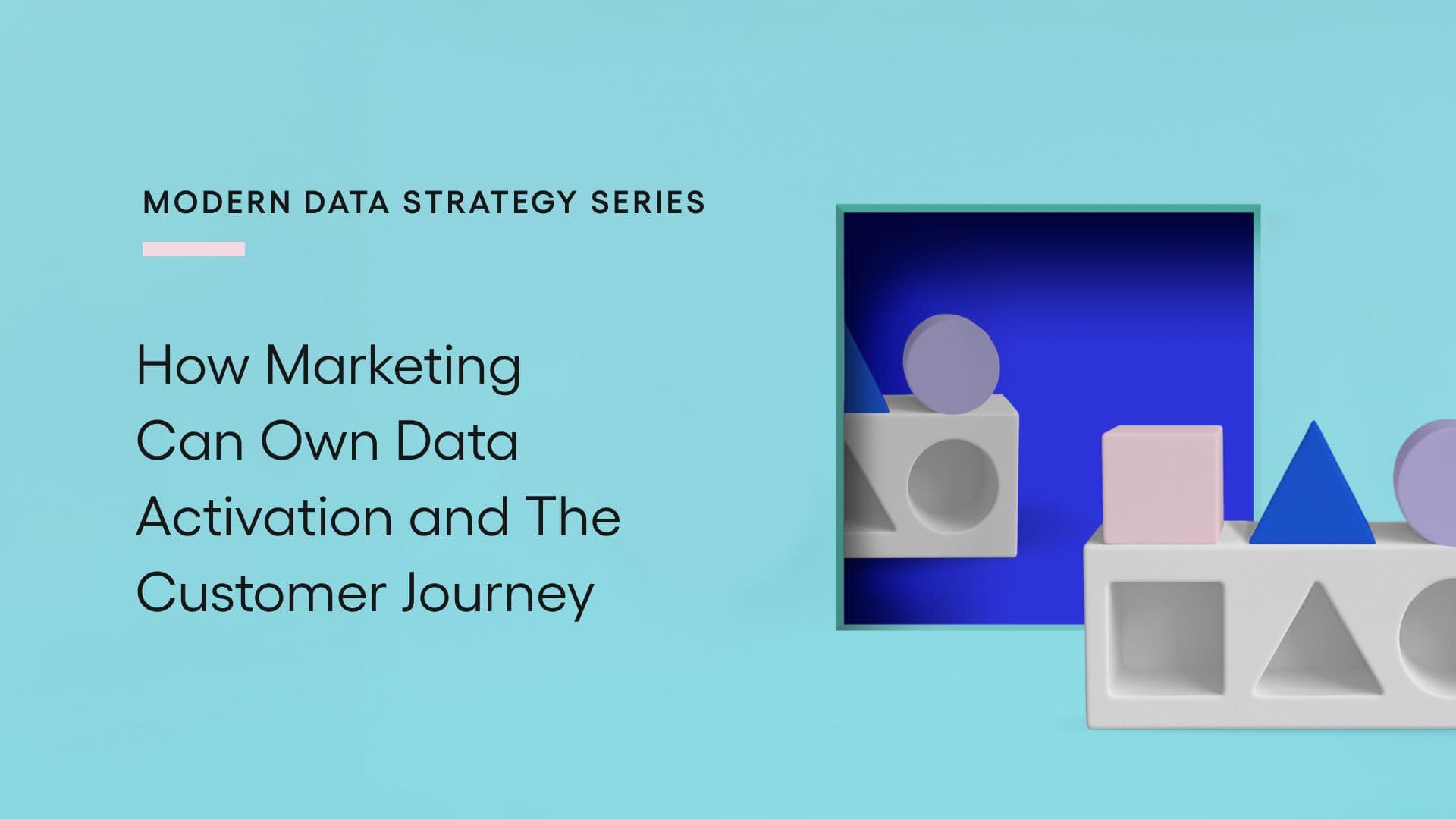How Marketing Can Own Data Activation and The Customer Journey
New technology allows marketers to act directly on their data-based insights
Marketers have always had a complicated relationship with their data. On one hand, marketing teams are tracking enormous volumes of complex new data that measures a detailed customer journey. The appetite for marketing data is growing across the entire organization. The data landscape is changing and that presents an enormous opportunity. Marketing leaders see a clear future where they evolve into data teams that can use analytics to uncover truths, tie their work to growth with more certainty, and increase credibility.
On the other hand, today they’re fighting a losing battle against unruly data systems. They have incomplete ownership of the most valuable data sources and constantly navigate an analytics environment full of inconsistent or outdated information. Even if they run a successful experiment and make a valuable discovery, they still need to work with product or engineering teams to take any action on it.
The disconnect between marketing’s past and its data-heavy future requires a technological reinvention. Marketers need tools that let them make more direct connections with customers (and prospects) at different points of their journey, including marketing channels and product experiences. They also need more accurate measurements of the behaviors that they’re influencing with those activations. The endpoint of the current data infrastructure evolution is a new type of marketing function: one that has the autonomy to move in real time between campaign data and personalized product experiences.
The marketers of the future will have better agility and autonomy to influence the experience for any type of customer. It'll be a long journey with lots of new skills to learn and new processes to master (like leading a team of AI Agents). The first step of that journey is a deeper understanding of the state of the modern consumer.
The modern consumer’s relationship with data
Today’s consumers are extremely aware of the digital landscape around them. They know that their data is being collected and their clicks are being monitored and they expect that information to translate to a personalized experience. In many cases, they even expect companies to use that data in a competition to offer the most personalized experience. Because of that expectation, they have almost no brand loyalty or patience; they’re all willing to shop around and jump at whatever the best offer is at the time.
For the marketing team trying to attract that consumer, the process has long been nonlinear. The path to purchase is complex and circular. Worst of all, the variance from one target to another is enormous. The digital space is wide and deep across a variety of channels, so the quantity of new touchpoints is expanding exponentially. It’s impossible to combine data points from all channels across different consumer devices and map them into a traditional marketing stack.
The only option for marketing teams is to adopt an infrastructure that uses a CDP to connect all that multichannel data into a single customer view for activation. No matter how an individual consumer interacts with a company (search ad, social media page, email campaign, website visit, app activity etc.) that activity has to be tied back to the individual person. With that robust set of data about individual users, it’s far easier to tailor, optimize, and track audience campaigns. It takes a lot more data setup on the marketer’s part to build that 360° view, but consumers expect that level of service and might even require it to make a purchase.
Why marketers struggle to act on data
Traditionally, marketing teams are charged with a high-level goal of helping a business grow. Without a data infrastructure that can directly measure their impact on growth, marketers usually end up settling for proxies like page views or last-touch attribution. That general goal can’t initially be measured accurately, so it ends up getting watered down and forced into a metric that is easier to report on.
Think about the metrics that your marketing team reports on the most frequently. Are you sharing data about product actions, retention, and engagement? Or are you still focused on email conversion rate and social media clicks?
It’s ok if you’re still providing data about the very top of the funnel. Almost everyone is. It’s all anyone has ever done. The data is easily compared to previous years, quarters, and campaigns. The numbers generally move in the right direction, so it’s easier to get budget approved for the next iteration. But it’s impossible to connect your marketing activities to actual revenue growth. If you zoom out enough, you might be able to draw dotted lines that can use general conversion rates and multipliers to get an activation estimate. That’s not going to be good enough to win the new type of customer for much longer.
To be clear, the issue isn’t that marketing teams don’t want to connect a wide range of data sources to provide personalized experiences and report on changes in product behavior. Of course they do, they just can’t. Their marketing stack is built from too many disjointed pieces that either don’t connect at all or don’t sync in real time. They can’t connect the dots with accurate data from all the way through the customer journey. The process is either impossible or it happens so slowly that the personalized activation happens too late to be effective.
The reality of marketing’s activation efforts is that the most valuable work is done in the data connections. Ideally, marketers have an environment that lets them see a cohort of users behaving in a certain way and can send that group personalized messages through specific channels in real time, but that type of flexible activation tactic is only possible with a significant overhaul of the data management strategy.

How marketing technology and tactics are evolving
Marketing teams have long focused on combining the right message for a particular consumer with the right channel and the right timing. By connecting customer data to activation, marketers have a much better ability to realize that goal.
What we’re seeing with today’s consumers is that the right channel is often the product itself and the right time is immediately. The modern marketing stack is full of rich user-level information and powerful enough to push messaging back out into new channels in real time. It lets marketers speak to users right in the product right now and collect feedback data almost instantly.
Amplitude built Guides and Surveys for marketing teams that want to send users real-time nudges about product or marketing offers. These Guides can be tailored to narrow cohorts to act as extremely accurate messaging laboratories that tear down traditional communication barriers.
Unlike most of the data marketers already analyze, Surveys allow teams to collect direct, qualitative data that they can categorize as revenue or brand “indicators”—affinity, intent, sentiment, etc. By combining this data with the quantitative metrics in Analytics and Experimentation, marketers will be working with a much more complete picture of how users are thinking and acting.
Consider the instance of a new web feature launch. Marketers can use CDP data to identify existing customers who already use related features and are likely to be interested in trying the new one. Below are two different cross-sell approaches, powered by different marketing technologies.
- The old stack (email-based marketing): Marketing sends a blanket email that hits all qualified users at the same time and requires them to click into the product then follow a set of directions from the email to set up a free trial.
- The new stack (user-based personalization): When a qualified user visits the web site, they see a personalized guide that explains the new feature and shows them where to click to start a free trial.
The new approach is clearly better.
The end result of all the data into and out of the marketing team will be an explosion of data-backed personalization. The experiments that marketing runs can be validated quickly to fuel product-led growth strategies.
The data landscape is full of opportunities for marketers to take control of the consumer experience. The aim should be to co-own interactions that historically have belonged solely to product or engineering teams. Taking that leap requires a shift in focus from data access to data activation. The teams that are willing to reorganize around influencing customer interactions are the ones who will jump ahead in the next iteration of the data landscape.

Michael Clair
Global Solution Architect, Amplitude
Michael Clair is a Global Solution Architect at Amplitude, leading the Solutions Engineering Data Infrastructure team. With 15 years of expertise in analytics, he specializes in designing and implementing impactful data solutions that deliver reliable, actionable outcomes.
More from MichaelRecommended Reading

AskNicely Cuts Analysis Time by 75% with Amplitude AI
Jan 6, 2026
8 min read

The Product Benchmarks Every Travel and Hospitality Company Should Know
Jan 5, 2026
5 min read

The Product Benchmarks Every Healthcare Company Should Know
Dec 29, 2025
5 min read

The Product Benchmarks Every Media and Entertainment Company Should Know
Dec 23, 2025
5 min read

